Your Guide to the Ultimate AI Music Remixer
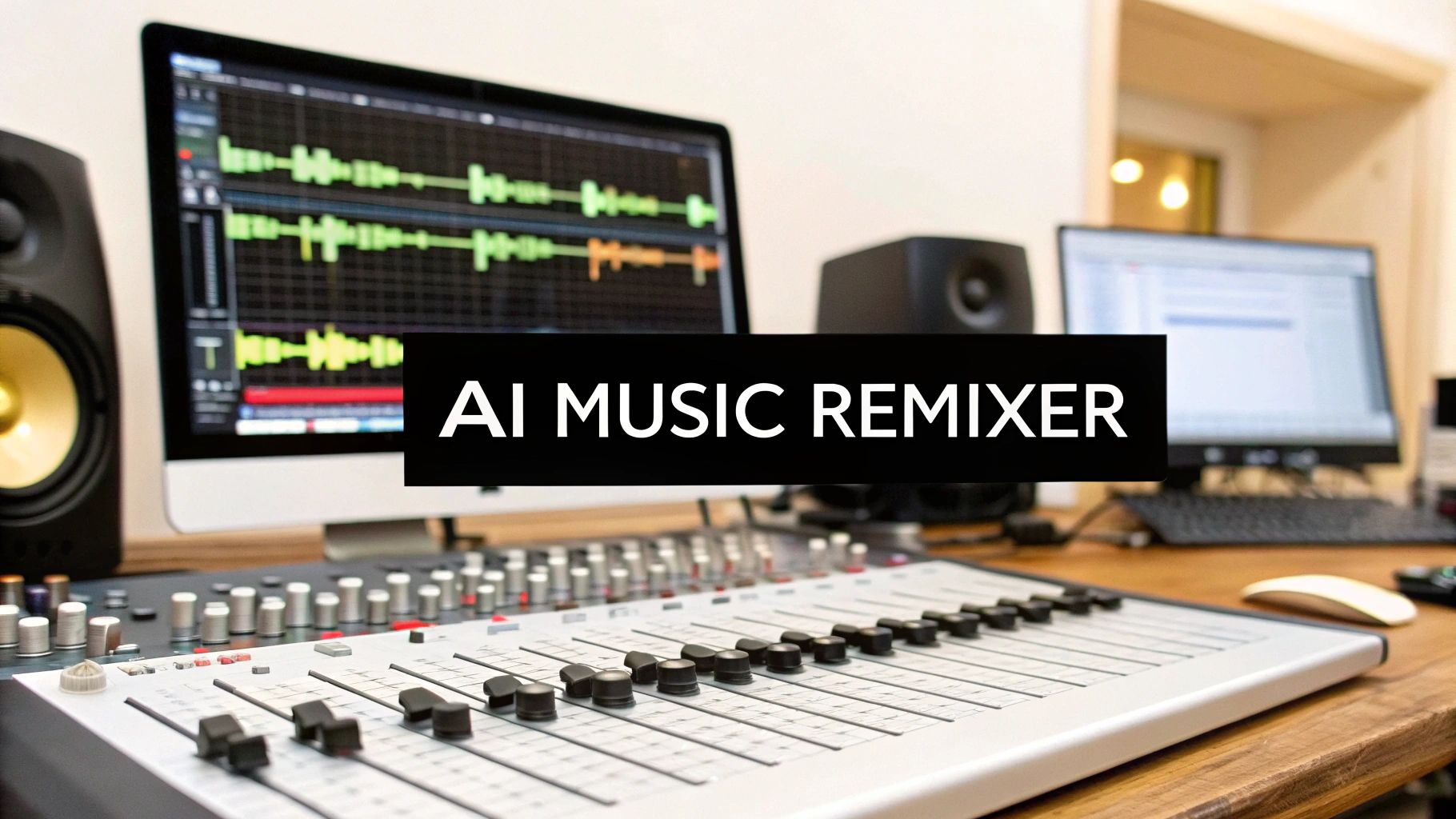


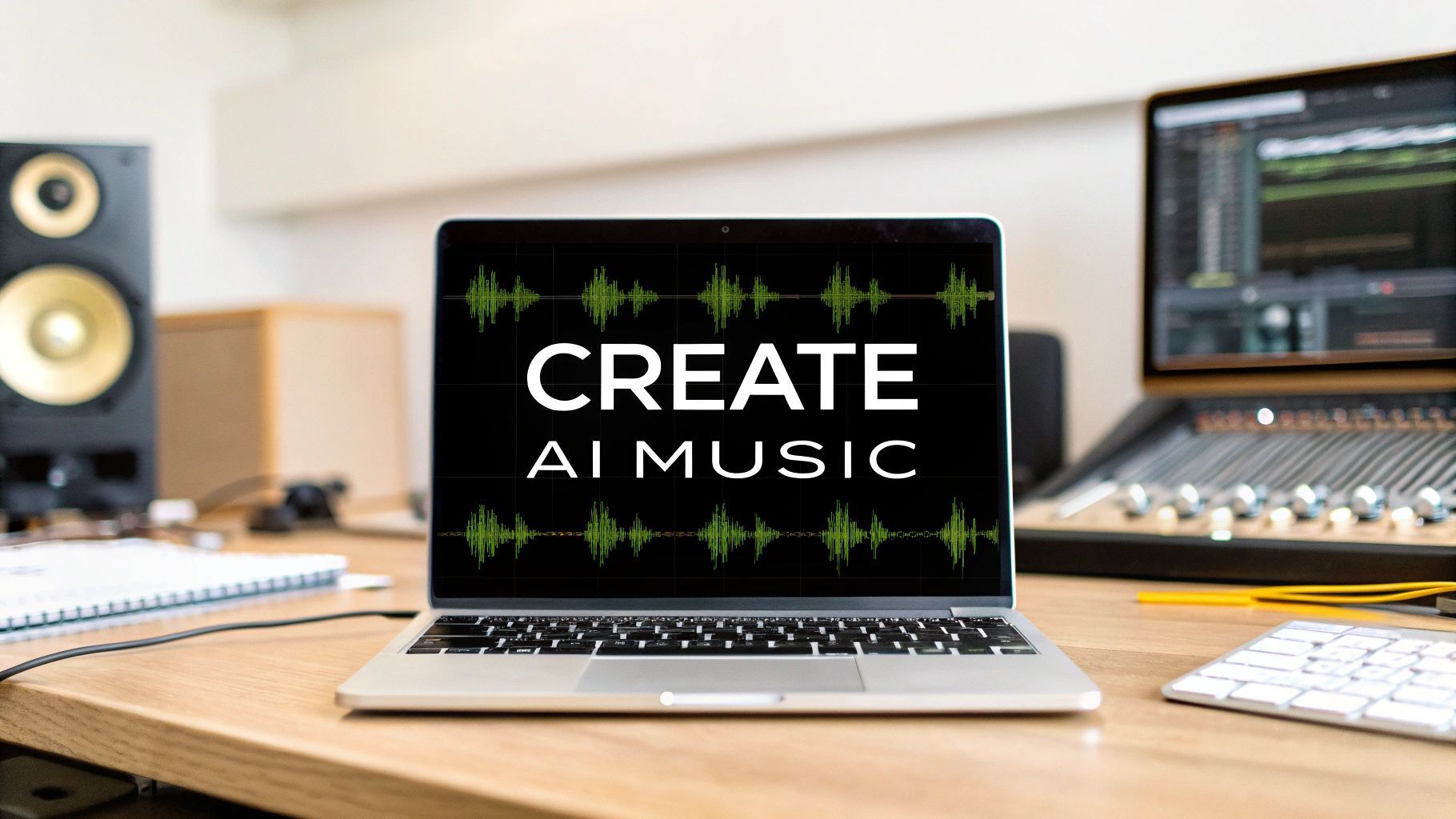
Want to create AI music but don't know where to start? This guide covers everything from your first prompt to mastering your final track. Jump in!
So, you want to make AI music? All it really takes is a solid AI music generator, a good idea of what you want, and a little bit of time to play around. You just type in what you're imagining—something like "energetic synthwave track for a workout video, 140 BPM, retro 80s feel"—and the AI whips up a completely original track just for you. For creators who need fresh, original music without shelling out a fortune, this is a total game-changer.
It feels like just yesterday AI music was something out of a sci-fi movie. Now, it's a go-to tool for your favorite YouTubers and content creators. This isn't just some fleeting trend; we're witnessing a massive shift in how music gets made. The old walls are crumbling—you no longer need years of music theory or a studio packed with expensive gear to create something amazing.
The hype is real because the results are immediate. Content creators can pump out royalty-free background music in seconds, dodging copyright claims and sidestepping those hefty licensing fees. Indie game developers can score an entire game without a composer's budget. And musicians hitting a creative wall can spark new ideas with a melody generated in an instant.
Don't think of an AI music generator as a machine that's here to replace artists. Think of it as your new creative sidekick. It’s a collaborator that’s always on, has an encyclopedic knowledge of every genre imaginable, and can spitball hundreds of ideas in the time it takes you to make a coffee. This kind of partnership is completely changing the creative game.
The numbers don't lie. The global market for AI-generated music is exploding and is expected to hit around $2 billion by 2025. On top of that, it's estimated that something like 60% of music producers will be weaving AI into their process soon, often slashing their production time in half.
"The biggest myth about AI music is that it's soulless. The reality is that it's a reflection of the creator's prompt. The soul, the emotion, the direction—it all comes from you. The AI is just the instrument."
Today's tools have made getting started ridiculously easy. Forget needing to know the circle of fifths or getting lost in a maze of confusing software. Platforms like SendFame were built to be intuitive, putting the power to create right at your fingertips. If you want to dive deeper into the nuts and bolts, our guide on what AI music is is a great place to start.
Just take a look at how clean and simple the interface can be on a modern generator.
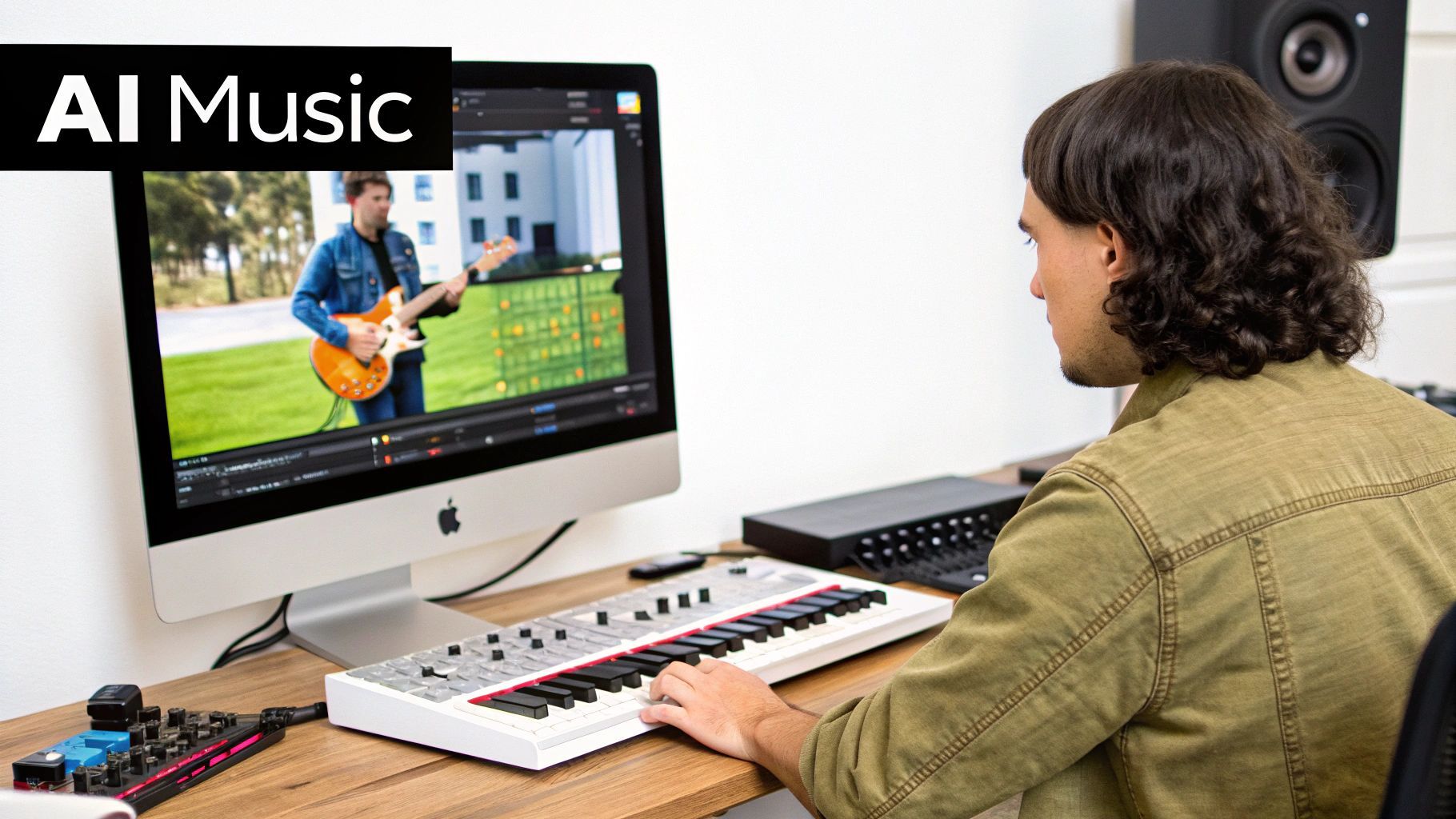
See? It’s all about simplicity. You get a prompt box for your creative vision and a big, obvious button to make it happen. This design proves you don't need a cockpit full of knobs and dials to produce professional-sounding music.
Alright, let's dive into your first jam session with an AI music generator. Firing up a new creative tool for the first time can feel a little intimidating, but trust me, this is where the fun begins. We're about to take that killer tune you've got in your head and turn it into something real with SendFame's Music Generator.
When you land on the dashboard, you’ll see it’s refreshingly simple. Your command center, your creative cockpit, is the prompt box. This is where you'll speak your musical vision into existence. The quality of what you get back is a direct reflection of what you put in.
Most people’s first instinct is to type something like, "upbeat pop song." And sure, the AI will spit something out, but it'll probably sound like royalty-free music from a 2008 corporate training video. It's bland because the instruction is bland.
You have to give the AI something to work with! Think of it less like a search engine and more like a session musician who needs clear direction.
Instead of just "upbeat pop song," let's give it some soul. How about this?
"Energetic, bubblegum pop track with a driving four-on-the-floor kick drum, shimmering synths, and a catchy, wordless female vocal hook. Think 125 BPM, perfect for a summer road trip montage."
See the difference? We've given it a genre, a vibe, instrumentation, a tempo, and even a use case. The result will be something that actually sounds intentional and polished. This is the secret sauce to mastering AI prompts, and it’s a skill that pays off big time.
Getting great results from an AI is all about providing the right details. The more specific your ingredients, the better the final dish will be. Let’s look at a side-by-side comparison to really drive this home.
| Crafting a Prompt That Gets Results | |||
|---|---|---|---|
| Element | Vague Prompt Example | Specific Prompt Example | Why It Works Better |
| Genre/Mood | "Scary music" | "Tense, atmospheric horror score with dissonant strings and a slow, ominous heartbeat-like drum." | "Scary" is subjective. The specific prompt paints a clear picture of the type of horror you're after. |
| Instrumentation | "Acoustic song" | "Gentle, fingerpicked acoustic guitar melody with a soft, warm cello accompaniment and subtle rain sounds." | This specifies the instruments and their playing style, creating a much richer sonic texture. |
| Tempo/Rhythm | "Fast electronic track" | "High-energy Drum and Bass track at 174 BPM with a complex, syncopated breakbeat and a deep, wobbly sub-bass." | "Fast" is relative. A specific BPM and rhythmic description provide a solid foundation for the AI to build upon. |
| Use Case | "Podcast intro" | "Quirky, upbeat lo-fi hip hop intro for a comedy podcast, featuring a playful piano loop and a simple boom-bap beat." | Telling the AI the purpose of the music helps it dial in the perfect vibe for the context. |
By being this descriptive, you’re not just making music; you're directing a virtual orchestra.
This detailed approach is what truly unlocks the power of an AI music creator. You get to skip hours of tedious work and jump straight to the creative part.
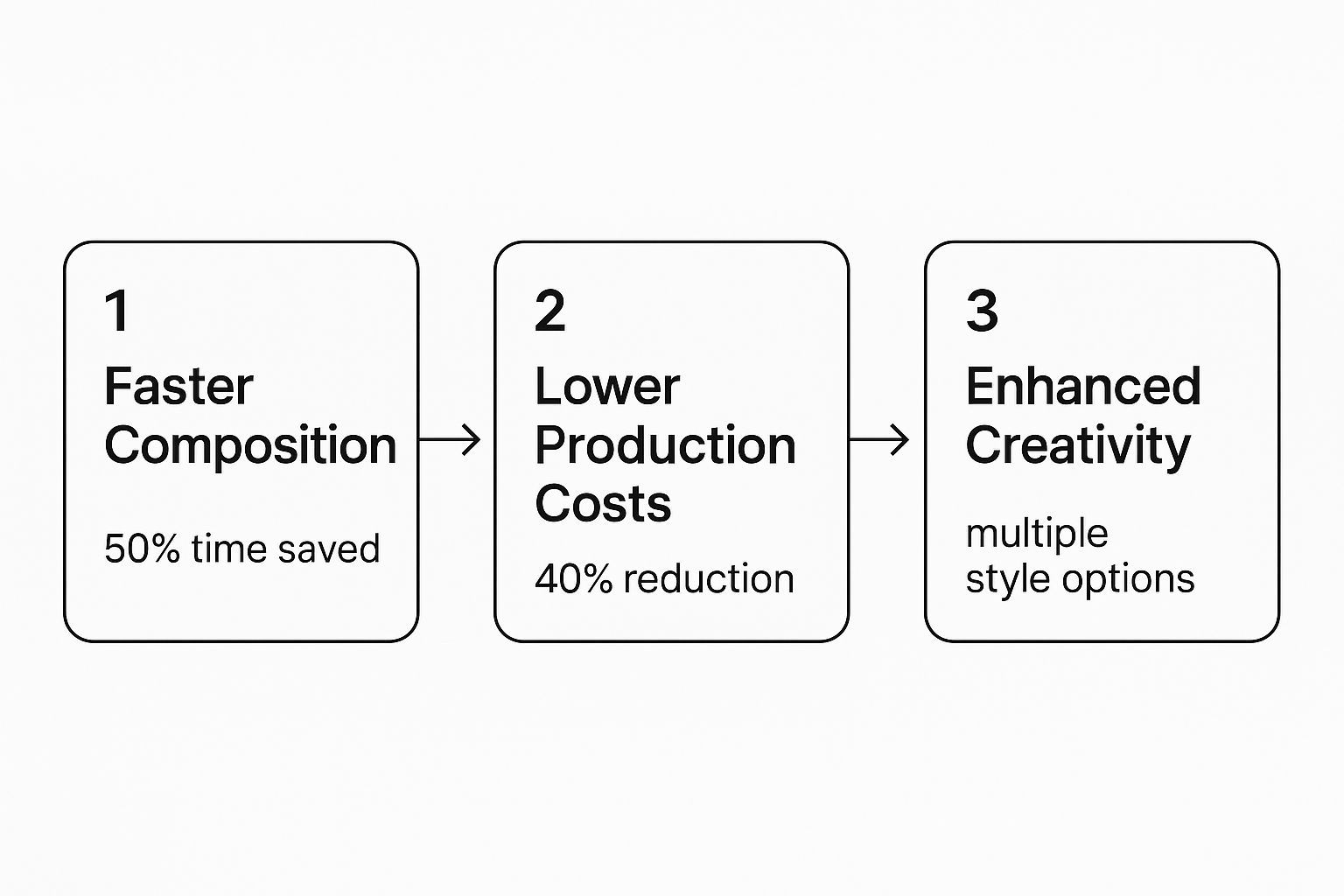
As you can see, this isn't just a novelty. These tools can genuinely slash production time and costs, which means you have more time and budget to focus on the bigger picture.
Now it's your turn. Grab that detailed prompt we workshopped, drop it into the generator, and hit that magic button. In a few moments, you’ll have a completely original piece of music made just for you.
Welcome to the club, composer. Now go have fun and see what you can create.
So, you’ve got your first track. That initial thrill of hearing an AI spit out something based on your prompt is pretty wild, right? But hold on, that's just the starting block. Now, we get to the really good part—turning that rough draft into something that sounds genuinely you. This is where you go from just using a tool to actually starting to create ai music.
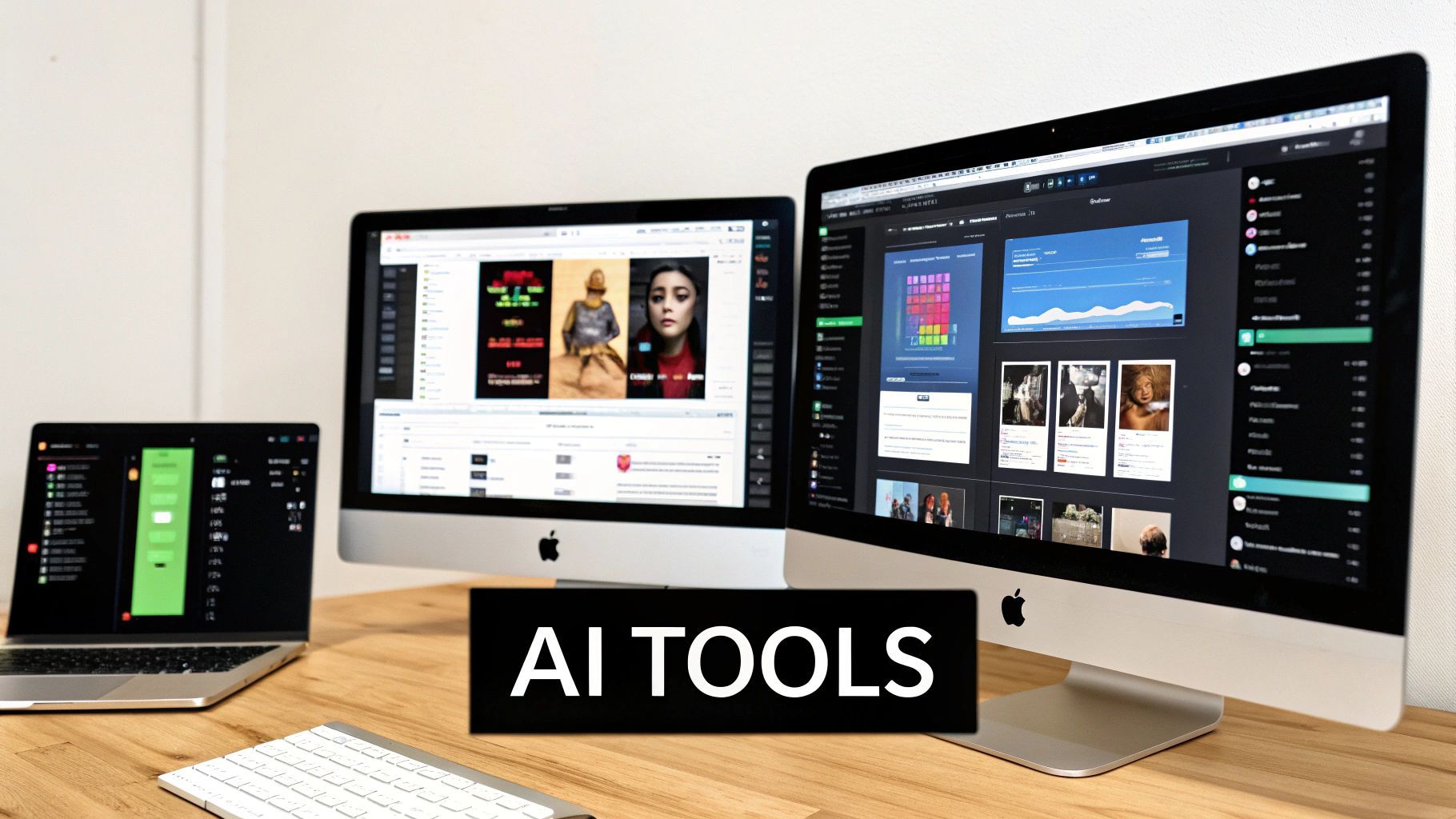
Think of the AI's first attempt like a session musician who followed your instructions perfectly but maybe missed the vibe. It did what you asked, but now it’s your job as the producer to coach that performance. The best generators are loaded with tools that let you get your hands dirty and fine-tune every little detail.
Your job just switched from writing prompts to producing a record. This is where you get to dissect the track and mess with all the moving parts. Instead of hitting "regenerate" and hoping for the best, you can now target specific elements.
Let's say the AI gave you this killer synth line, but the drums sound like they came from a cheap keyboard. Easy fix. You can dive in and swap that generic beat for a heavy, retro 80s drum kit. The melody you fell in love with is still there, but the whole personality of the song has changed in an instant.
This kind of detailed control is becoming the new normal. For perspective, North America cornered about 40% of the AI music generator market in 2023, largely because the creative and tech industries there demand these more advanced features. This competition pushes platforms to give creators the granular control they crave. You can dig into more of this market data over at dataintelo.com.
Let's make this practical. You generated a nice, mellow ambient track for your podcast intro. Perfect. But now you need a super energetic version for your YouTube channel’s opener. You don't have to start from scratch.
Here’s a simple game plan:
Clone the Project: First things first, duplicate the track so you don't lose that original chill version. Crank the Speed: Nudge the tempo up by 20 or 30 BPM. Instantly, the track has more life. Change the Bass: That smooth, long bass note won’t cut it. Swap it out for a punchy, rhythmic synth bass that drives the beat. Layer on Drums: Add some sharp hi-hats and a solid snare to build real momentum.
This back-and-forth is how you get the most out of a single idea. One great AI generation can be the seed for five completely different tracks, each perfectly suited for a different need—from a moody film score to a quick beat for a TikTok video.
This approach is a massive time-saver and helps you build a consistent sound across all your content. If you want to get back to basics, our guide on how to make AI-generated music is a great place to brush up.
But here’s the real pro move: mix the AI with your own talent. Many tools let you download the individual instrument tracks, or "stems." You can drag these right into a Digital Audio Workstation (DAW) like Logic Pro, Ableton Live, or even the free GarageBand. From there, you can record your own vocals over the top or lay down a guitar solo, creating a hybrid track that is 100% unique.
Making killer tracks is one thing, but turning them into a real asset is a whole different ball game. Before you start uploading your AI-generated bangers everywhere, let’s talk business. The first, and most important, hurdle is figuring out who actually owns the music.
The answer can be a bit tricky, but it almost always comes down to the terms of service of whatever platform you're using. Most reputable AI music generators, like SendFame, grant you a full commercial license for the music you create. This means you can drop it into your monetized YouTube videos, podcasts, or indie games without waking up to a copyright strike.
But seriously, always check the fine print. Some platforms have weird restrictions, and a quick skim of their licensing agreement can save you a massive headache later. It's the difference between confidently building your brand and accidentally stepping on a legal landmine.
The music industry is going through a seismic shift, and AI is right at the epicenter. This isn't just a fun new toy; it's a massive economic force that’s fundamentally changing how music is made, valued, and sold. The numbers are staggering and paint a wild picture of an industry on the brink of a complete overhaul.
Market analyses show the AI music sector is set for explosive growth, predicted to rocket from $3.9 billion in 2023 to an incredible $38.7 billion by 2033. But here's the rub: a Goldmedia study projects that human musicians could see their revenue drop by a whopping 27% by 2028 if AI music floods the market without fair compensation models. Feel free to dive deeper into these industry statistics to get the full scope of this shift.
This isn't just about cool tech; it's about ethics. The entire conversation is now moving toward building a fair system where AI tools help human artists, not replace them. The goal is to make sure everyone gets a fair slice of the pie.
So, where do you fit into all of this? As a creator, you’re in a prime position. You have access to tools that can spin up unlimited, high-quality, royalty-free music tailored specifically to your needs. That's a huge advantage.
Here are a few ways to jump on this opportunity:
Content Creation: Churn out unique background music for all your videos, podcasts, and streams. You can literally create a signature sound for your brand in an afternoon. Indie Projects: Need to score an entire video game or short film? Now you can do it without emptying your bank account to hire a composer. Client Work: Offer custom track creation as a service for other creators or small businesses who need original audio but don't have the time or skills to make it themselves.
The key is to see AI as more than just a music maker—it's a business tool. Once you understand the rules of the road and see where the market is headed, you can effectively create AI music that not only sounds great but also works for you financially.
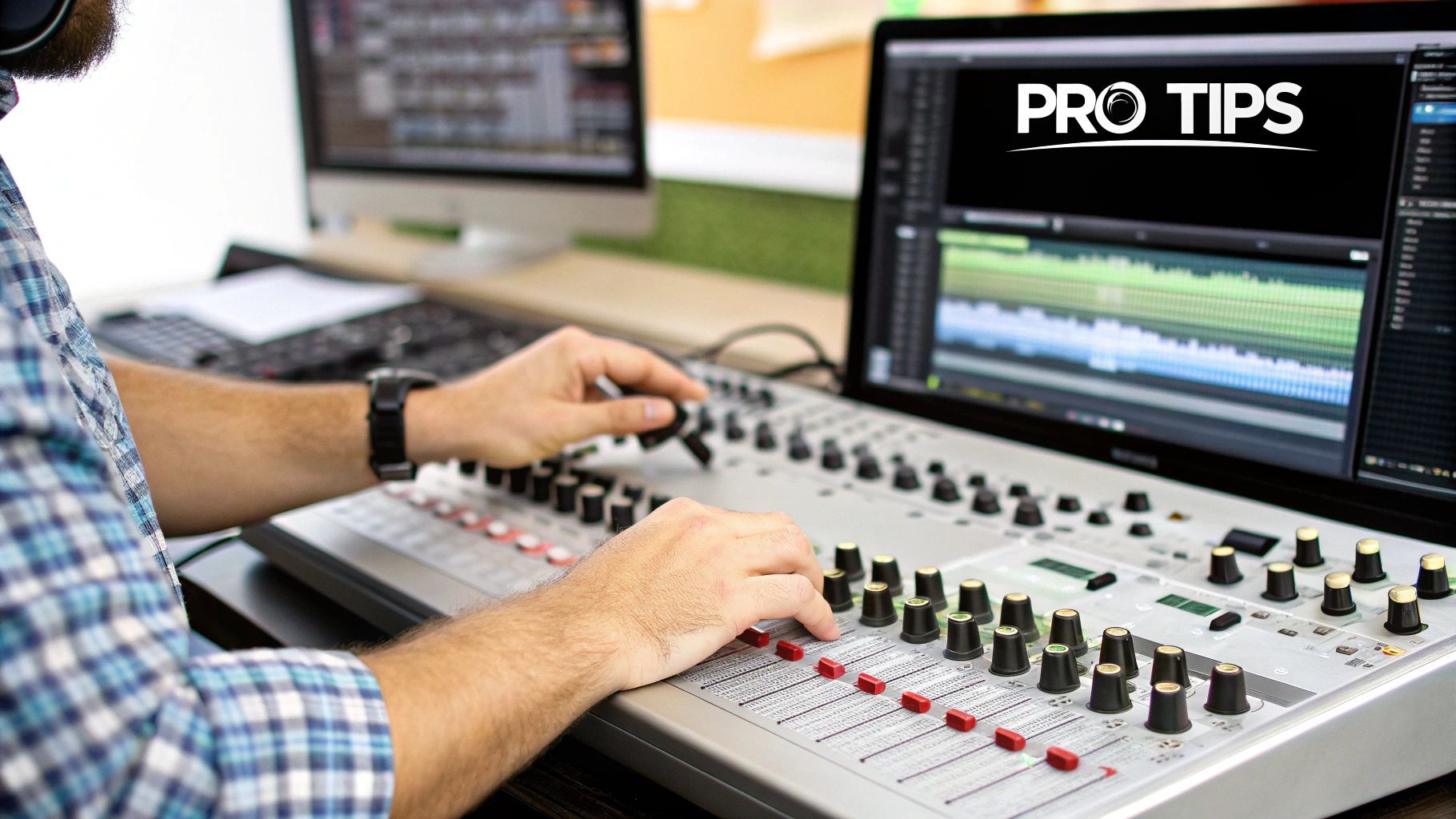
Alright, you've done it. The synths are shimmering, the beat drops just right, and your final mix is officially exported. High-five yourself! But let's be real—a masterpiece collecting digital dust on your hard drive isn't going to top any charts. It's time to unleash your creation.
You might think that getting your music onto heavy-hitters like Spotify, Apple Music, and Amazon Music is some exclusive club for signed artists. Nope. It's actually way more accessible than you think. The secret is using a digital music distribution service. These platforms are your backstage pass, the bridge between your final audio file and the ears of millions.
They take care of all the boring technical stuff, making sure your track is formatted correctly for each platform. Even better, they're the ones who chase down and collect your royalties every time someone streams your song.
Before you even think about hitting "upload," you need to get your metadata on point. This is the nuts and bolts info that tells streaming services everything they need to know about your track. Without it, your song is basically a ghost in the machine.
At the very least, have this info ready to go:
Artist Name: Your musical identity, your brand. Song Title: What are you calling this masterpiece? Genre: Don't be vague. "Electronic" is fine, but something specific like "Synthwave" or "Lo-fi Chill Hop" will help the right listeners find you. Album Art: A killer square image, usually 3000x3000 pixels, that visually captures the vibe of your track.
Seriously, don't sleep on your metadata. It's how you get found, how you get on playlists, and—most importantly—how you get paid. Taking an extra five minutes to triple-check every detail will save you from a world of pain down the line.
Landing on a major streaming platform is a fantastic feeling, but why stop there? The music you create is a powerful asset, and now you have a library of completely original, royalty-free tracks you can use anywhere.
The possibilities are endless. Think about it:
Social Media Domination: Stop using the same overplayed tracks as everyone else. Now you have custom background music for your Instagram Reels, TikToks, and YouTube Shorts.Podcast Pro: Craft a unique intro, outro, and transition score that makes your podcast sound ridiculously professional.Indie Game Soundtrack: You can score an entire video game with a dynamic, AI-generated soundtrack that won't cost you a fortune.Killer Video Content: A great track deserves great visuals. You can even take it a step further and see how an AI music video generator can create a stunning visual companion for your song, giving you a full-on promotional package.
Once your track is live, it's time to make some noise! Share it everywhere, send it to playlist curators, and tell your friends. This is the final step—turning that audio file into an experience you can be proud of. Go get 'em.
So, you're curious about AI music. That’s smart. It's a wild new space, and it’s totally normal to have a few questions before you jump in. Let's get them answered.
This is the million-dollar question, isn't it? The simple answer is, it really depends on the tool you're using.
A platform built for creators, like SendFame, is going to give you a full commercial license. That's the whole point. It means you can use your tracks in YouTube videos you monetize, in ads for your business, or pretty much any commercial project you can dream up without worrying about getting a dreaded copyright takedown notice.
But here’s my pro tip: always, always read the terms of service. I know, it's boring, but a five-minute scan can save you a world of hurt later on. Some services have weird little clauses about where and how you can use the music. Think of it as your creative pre-nup.
Honestly, only if you tell it to. The old stereotype of AI music being a soulless, generic mess comes from outdated tech. The generators we have now are on a completely different level. The music they produce is a direct reflection of the instructions you give them.
If you type in "sad song," you're going to get something predictably bland. But get specific. Try something like, "a melancholic lo-fi piano melody for a rainy night, maybe around 80 BPM, with some light vinyl crackle in the background." See the difference? You're giving the AI the emotional and textural hooks it needs to create something that actually feels human and unique. You're the conductor, and the AI is your personal, infinitely talented orchestra.
The biggest mistake I see people make is thinking they're just pushing a button. You're not. The AI provides the raw material, but you provide the soul. The more creative and detailed your prompts are, the better the music will be.
Oh, absolutely. And this is where it gets really fun. The first track the AI spits out is just the beginning—your rough draft. The best AI music tools let you get under the hood and mess with everything.
What can you do? A lot, actually.
Change up the instruments. That synth not doing it for you? Swap it for a gritty electric guitar. Play with the tempo and key. You can speed things up to build energy or slow it way down for a more somber, dramatic vibe. Get your hands on the stems. This is huge. You can download the individual tracks—just the drums, just the bass, just the melody—and pull them into your own editing software for a proper mix and master. This gives you the ultimate control.
This is what makes it a true collaboration. You bring the vision and the taste, and the AI brings the technical execution. Together, you can make something that's genuinely yours.
Ready to give it a shot? Stop wondering and start creating. With SendFame, you can generate royalty-free, high-quality tracks in just a few seconds. Head over to https://sendfame.com and see what you can cook up.
Create Epic
SendFame